maintenance YAMAHA GIGGLE50 2009 Owners Manual
[x] Cancel search | Manufacturer: YAMAHA, Model Year: 2009, Model line: GIGGLE50, Model: YAMAHA GIGGLE50 2009Pages: 74, PDF Size: 0.9 MB
Page 6 of 74
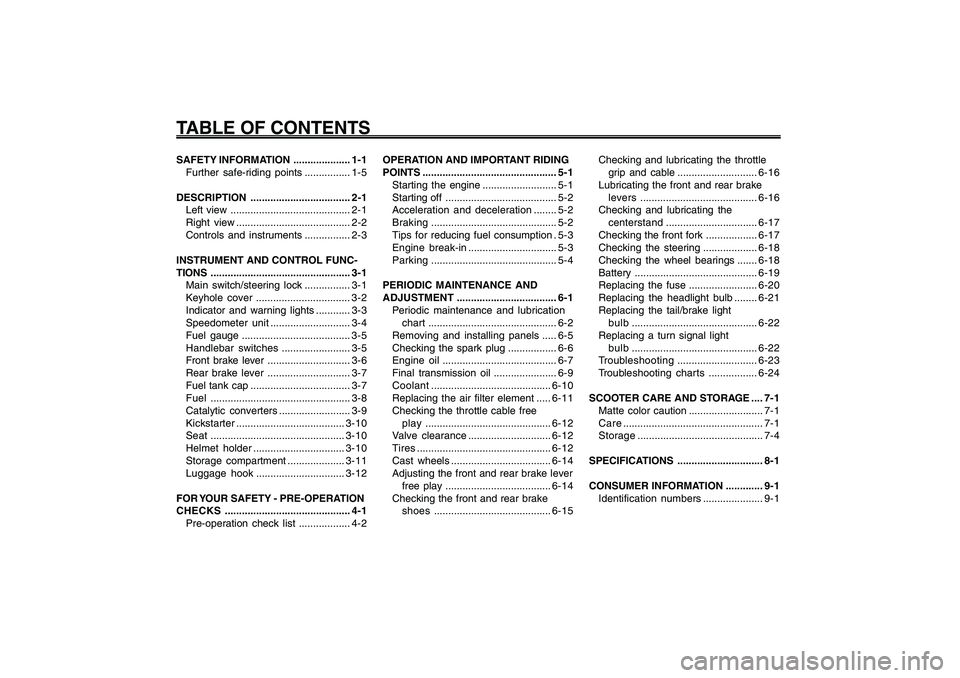
1
2
3
4
5
6
7
8
9
EAU10210
TABLE OF CONTENTSSAFETY INFORMATION .................... 1-1
Further safe-riding points ................ 1-5
DESCRIPTION ................................... 2-1
Left view .......................................... 2-1
Right view ........................................ 2-2
Controls and instruments ................ 2-3
INSTRUMENT AND CONTROL FUNC-
TIONS................................................. 3-1
Main switch/steering lock ................ 3-1
Keyhole cover ................................. 3-2
Indicator and warning lights ............ 3-3
Speedometer unit............................ 3-4
Fuel gauge ...................................... 3-5
Handlebar switches........................ 3-5
Front brake lever ............................. 3-6
Rear brake lever ............................. 3-7
Fuel tank cap ................................... 3-7
Fuel................................................. 3-8
Catalytic converters ......................... 3-9
Kickstarter......................................3-10
Seat...............................................3-10
Helmet holder................................3-10
Storage compartment ....................3-11
Luggage hook...............................3-12
FOR YOUR SAFETY - PRE-OPERATION
CHECKS............................................ 4-1
Pre-operation check list .................. 4-2OPERATION AND IMPORTANT RIDING
POINTS............................................... 5-1
Starting the engine .......................... 5-1
Starting off ....................................... 5-2
Acceleration and deceleration........ 5-2
Braking............................................ 5-2
Tips for reducing fuel consumption . 5-3
Engine break-in............................... 5-3
Parking............................................ 5-4
PERIODIC MAINTENANCE AND
ADJUSTMENT................................... 6-1
Periodic maintenance and lubrication
chart............................................. 6-2
Removing and installing panels ..... 6-5
Checking the spark plug ................. 6-6
Engine oil........................................ 6-7
Final transmission oil ...................... 6-9
Coolant..........................................6-10
Replacing the air filter element .....6-11
Checking the throttle cable free
play............................................6-12
Valve clearance.............................6-12
Tires...............................................6-12
Cast wheels ...................................6-14
Adjusting the front and rear brake lever
free play .....................................6-14
Checking the front and rear brake
shoes.........................................6-15Checking and lubricating the throttle
grip and cable ............................6-16
Lubricating the front and rear brake
levers.........................................6-16
Checking and lubricating the
centerstand................................6-17
Checking the front fork ..................6-17
Checking the steering ...................6-18
Checking the wheel bearings .......6-18
Battery ...........................................6-19
Replacing the fuse ........................6-20
Replacing the headlight bulb ........6-21
Replacing the tail/brake light
bulb............................................6-22
Replacing a turn signal light
bulb............................................6-22
Troubleshooting............................6-23
Troubleshooting charts.................6-24
SCOOTER CARE AND STORAGE .... 7-1
Matte color caution .......................... 7-1
Care................................................. 7-1
Storage............................................ 7-4
SPECIFICATIONS.............................. 8-1
CONSUMER INFORMATION ............. 9-1
Identification numbers..................... 9-1
Page 25 of 74
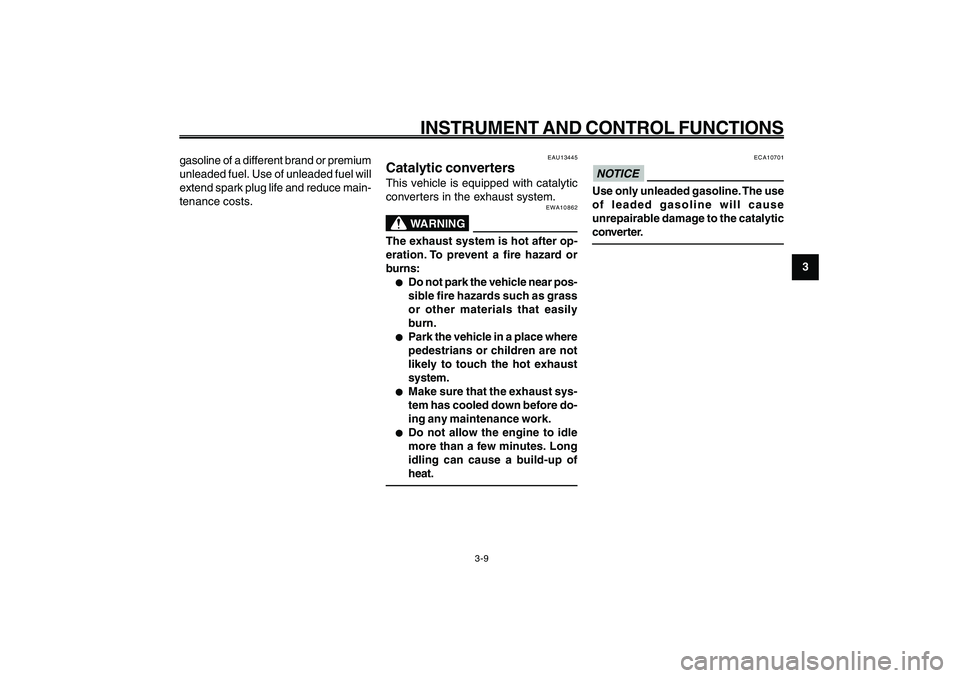
3-25
1
2
3
4
5
6
7
8
9
EAU1044E
INSTRUMENT AND CONTROL FUNCTIONS
3-9
Catalytic converters
EAU13445
Catalytic convertersThis vehicle is equipped with catalytic
converters in the exhaust system.
EWA10862
WARNING
The exhaust system is hot after op-
eration. To prevent a fire hazard or
burns:● ●● ●
●
Do not park the vehicle near pos-
sible fire hazards such as grass
or other materials that easily
burn.
● ●● ●
●
Park the vehicle in a place where
pedestrians or children are not
likely to touch the hot exhaust
system.
● ●● ●
●
Make sure that the exhaust sys-
tem has cooled down before do-
ing any maintenance work.
● ●● ●
●
Do not allow the engine to idle
more than a few minutes. Long
idling can cause a build-up of
heat.
ECA10701
NOTICEUse only unleaded gasoline. The use
of leaded gasoline will cause
unrepairable damage to the catalytic
converter.
gasoline of a different brand or premium
unleaded fuel. Use of unleaded fuel will
extend spark plug life and reduce main-
tenance costs.
Page 29 of 74
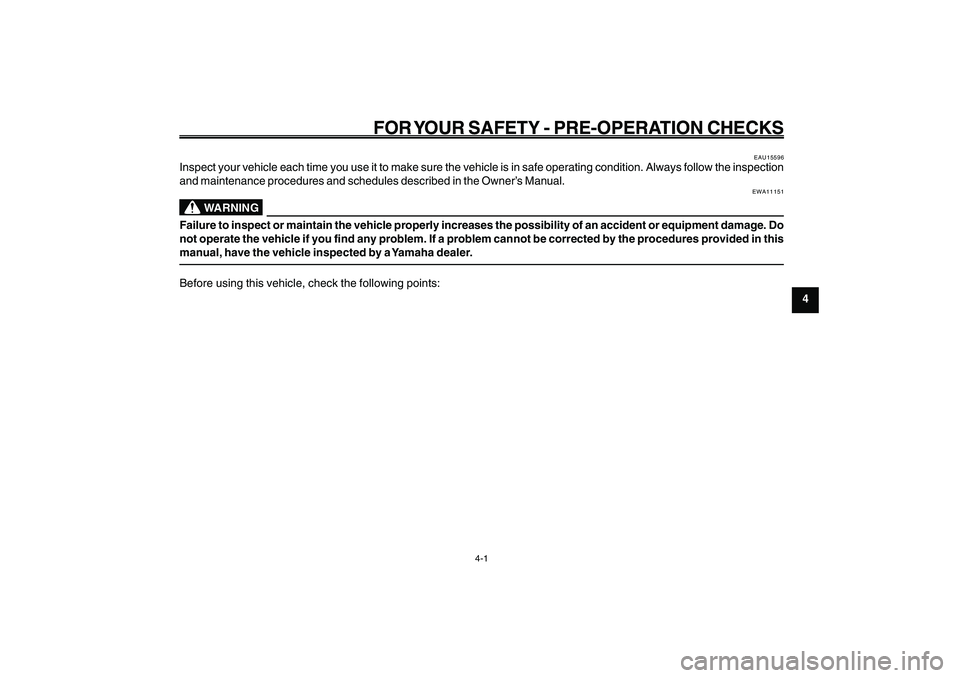
4-29
1
2
3
4
5
6
7
8
9
EAU15582
FOR YOUR SAFETY - PRE-OPERATION CHECKS
4-1
EAU15582
FOR YOUR SAFETY - PRE-OPERATION CHECKS
EAU15596
Inspect your vehicle each time you use it to make sure the vehicle is in safe operating condition. Always follow the inspection
and maintenance procedures and schedules described in the Owner’s Manual.
EWA11151
WARNING
Failure to inspect or maintain the vehicle properly increases the possibility of an accident or equipment damage. Do
not operate the vehicle if you find any problem. If a problem cannot be corrected by the procedures provided in this
manual, have the vehicle inspected by a Yamaha dealer.Before using this vehicle, check the following points:
Page 36 of 74
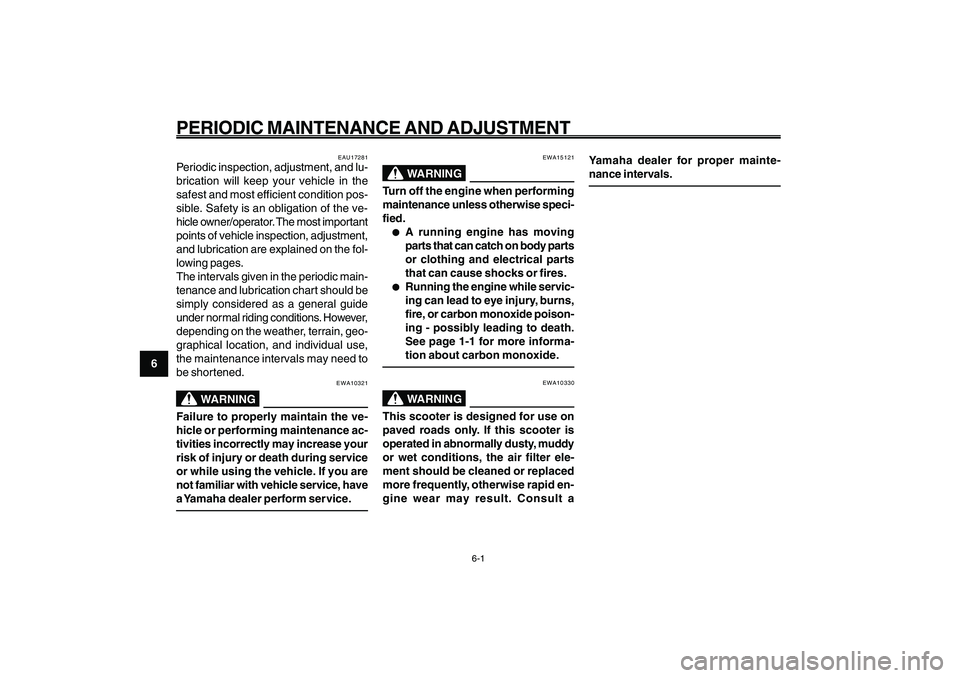
6-36
1
2
3
4
5
6
7
8
9
EAU1722A
PERIODIC MAINTENANCE AND ADJUSTMENT
EAU1722A
PERIODIC MAINTENANCE AND ADJUSTMENT
6-1
EAU17281
Periodic inspection, adjustment, and lu-
brication will keep your vehicle in the
safest and most efficient condition pos-
sible. Safety is an obligation of the ve-
hicle owner/operator. The most important
points of vehicle inspection, adjustment,
and lubrication are explained on the fol-
lowing pages.
The intervals given in the periodic main-
tenance and lubrication chart should be
simply considered as a general guide
under normal riding conditions. However,
depending on the weather, terrain, geo-
graphical location, and individual use,
the maintenance intervals may need to
be shortened.
EWA10321
WARNING
Failure to properly maintain the ve-
hicle or performing maintenance ac-
tivities incorrectly may increase your
risk of injury or death during service
or while using the vehicle. If you are
not familiar with vehicle service, have
a Yamaha dealer perform service.
EWA15121
WARNING
Turn off the engine when performing
maintenance unless otherwise speci-
fied.● ●● ●
●
A running engine has moving
parts that can catch on body parts
or clothing and electrical parts
that can cause shocks or fires.
● ●● ●
●
Running the engine while servic-
ing can lead to eye injury, burns,
fire, or carbon monoxide poison-
ing - possibly leading to death.
See page 1-1 for more informa-
tion about carbon monoxide.
EWA10330
WARNING
This scooter is designed for use on
paved roads only. If this scooter is
operated in abnormally dusty, muddy
or wet conditions, the air filter ele-
ment should be cleaned or replaced
more frequently, otherwise rapid en-
gine wear may result. Consult aYamaha dealer for proper mainte-
nance intervals.
Page 37 of 74
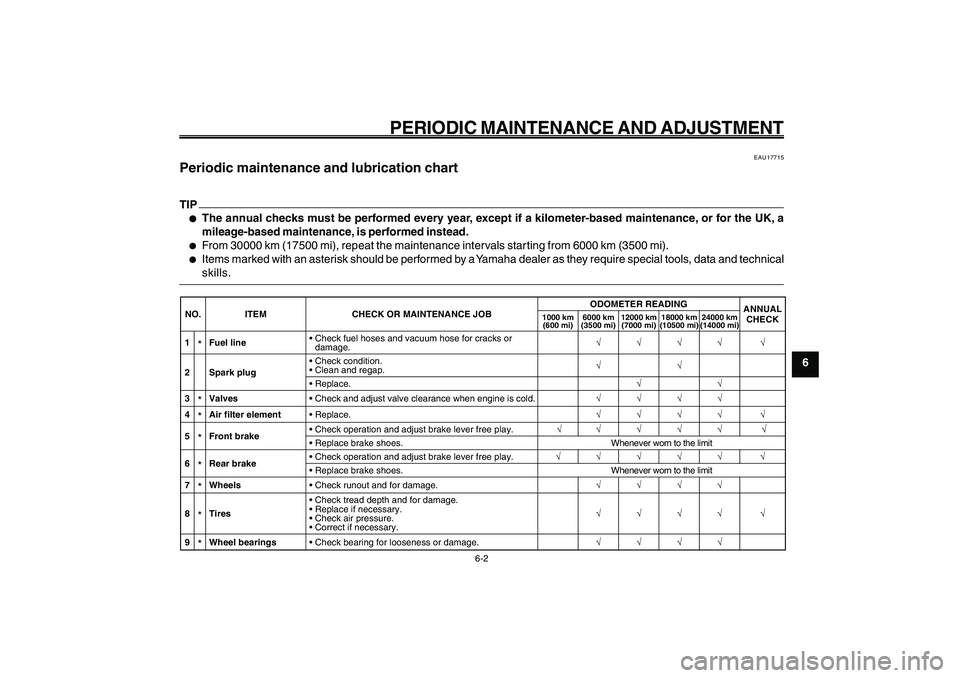
6-37
1
2
3
4
5
6
7
8
9
EAU1722A
PERIODIC MAINTENANCE AND ADJUSTMENT
6-2
Periodic maintenance and lubrication chart
EAU17715
Periodic maintenance and lubrication chartTIP● ●● ●
●
The annual checks must be performed every year, except if a kilometer-based maintenance, or for the UK, a
mileage-based maintenance, is performed instead.
●
From 30000 km (17500 mi), repeat the maintenance intervals starting from 6000 km (3500 mi).
●
Items marked with an asterisk should be performed by a Yamaha dealer as they require special tools, data and technical
skills.
NO. ITEM CHECK OR MAINTENANCE JOBODOMETER READING
ANNUAL
CHECK
1000 km
(600 mi)6000 km
(3500 mi)12000 km
(7000 mi)18000 km
(10500 mi)24000 km
(14000 mi)
1
*Fuel line• Check fuel hoses and vacuum hose for cracks or
damage.�—�—�—�— �—
2 Spark plug• Check condition.
• Clean and regap.�—�—
• Replace.�—�—
3*Valves• Check and adjust valve clearance when engine is cold.�—�—�—�—
4*Air filter element• Replace.�—�—�—�— �—
5*Front brake• Check operation and adjust brake lever free play.�—�— �— �— �— �—
• Replace brake shoes. Whenever worn to the limit
6*Rear brake• Check operation and adjust brake lever free play.�—�—�—�—�— �—
• Replace brake shoes. Whenever worn to the limit
7*Wheels• Check runout and for damage.�—�—�—�—
8*Tires• Check tread depth and for damage.
• Replace if necessary.
• Check air pressure.
• Correct if necessary.�—�—�—�— �—
9*Wheel bearings• Check bearing for looseness or damage.�—�—�—�—
Page 38 of 74
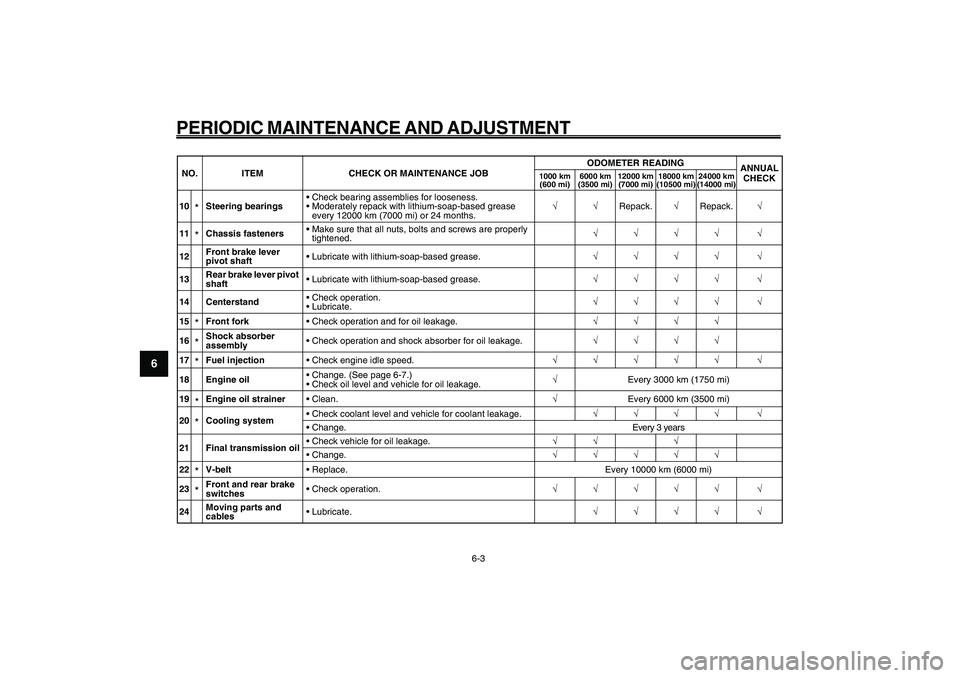
6-38
1
2
3
4
5
6
7
8
9
EAU1722A
PERIODIC MAINTENANCE AND ADJUSTMENT
6-3
10
*Steering bearings• Check bearing assemblies for looseness.
• Moderately repack with lithium-soap-based grease
every 12000 km (7000 mi) or 24 months.�—�—Repack.�—Repack.�—
11*Chassis fasteners• Make sure that all nuts, bolts and screws are properly
tightened.�—�—�—�— �—
12Front brake lever
pivot shaft• Lubricate with lithium-soap-based grease.�—�—�—�— �—
13Rear brake lever pivot
shaft• Lubricate with lithium-soap-based grease.�—�—�—�— �—
14 Centerstand• Check operation.
• Lubricate.�—�—�—�— �—
15*Front fork• Check operation and for oil leakage.�—�—�—�—
16*Shock absorber
assembly• Check operation and shock absorber for oil leakage.�—�—�—�—
17*Fuel injection• Check engine idle speed.�—�—�—�—�— �—
18 Engine oil• Change. (See page 6-7.)
• Check oil level and vehicle for oil leakage.�—Every 3000 km (1750 mi)
19
*Engine oil strainer•Clean.�—Every 6000 km (3500 mi)
20*Cooling system• Check coolant level and vehicle for coolant leakage.�—�—�—�— �—
• Change. Every 3 years
21 Final transmission oil• Check vehicle for oil leakage.�—�— �—
• Change.�—�—�—�—�—
22*V-belt• Replace. Every 10000 km (6000 mi)
23*Front and rear brake
switches• Check operation.�—�—�—�—�— �—
24Moving parts and
cables• Lubricate.�—�—�—�— �— NO. ITEM CHECK OR MAINTENANCE JOBODOMETER READING
ANNUAL
CHECK
1000 km
(600 mi)6000 km
(3500 mi)12000 km
(7000 mi)18000 km
(10500 mi)24000 km
(14000 mi)
Page 39 of 74
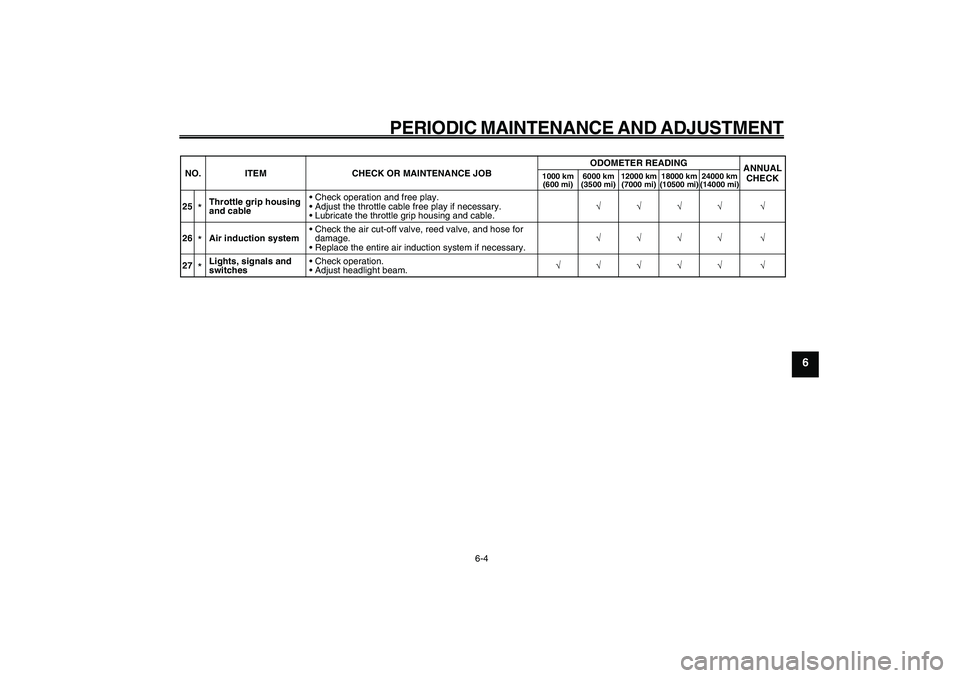
6-39
1
2
3
4
5
6
7
8
9
EAU1722A
PERIODIC MAINTENANCE AND ADJUSTMENT
6-4
25
*Throttle grip housing
and cable• Check operation and free play.
• Adjust the throttle cable free play if necessary.
• Lubricate the throttle grip housing and cable.�—�—�—�— �—
26*Air induction system• Check the air cut-off valve, reed valve, and hose for
damage.
• Replace the entire air induction system if necessary.�—�—�—�— �—
27*Lights, signals and
switches• Check operation.
• Adjust headlight beam.�—�—�—�—�— �— NO. ITEM CHECK OR MAINTENANCE JOBODOMETER READING
ANNUAL
CHECK
1000 km
(600 mi)6000 km
(3500 mi)12000 km
(7000 mi)18000 km
(10500 mi)24000 km
(14000 mi)
Page 40 of 74
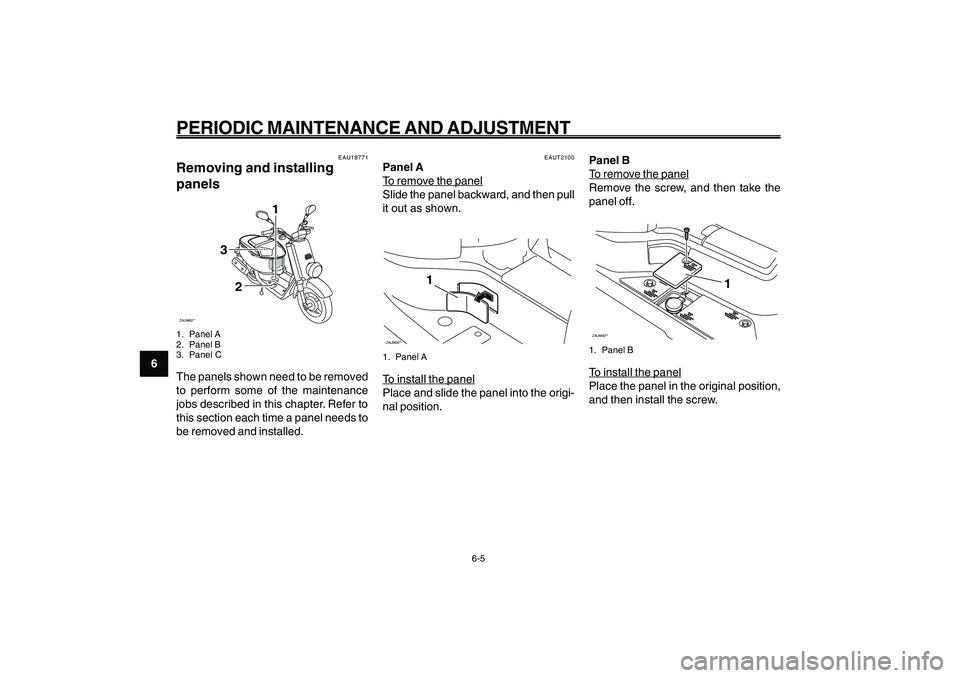
6-40
1
2
3
4
5
6
7
8
9
EAU1722A
PERIODIC MAINTENANCE AND ADJUSTMENT
6-5
EAU18771
Removing and installing
panelsZAUM00**
3
1
2
1. Panel A
2. Panel B
3. Panel CThe panels shown need to be removed
to perform some of the maintenance
jobs described in this chapter. Refer to
this section each time a panel needs to
be removed and installed.
EAUT2100
Panel ATo remo
ve the panel
Slide the panel backward, and then pull
it out as shown.
ZAUM00**
1
1. Panel ATo install the panel
Place and slide the panel into the origi-
nal position.Panel B
To remo
ve the panel
Remove the screw, and then take the
panel off.
ZAUM00**
1
1. Panel BTo install the panel
Place the panel in the original position,
and then install the screw. Panels, removing and installing
Page 41 of 74
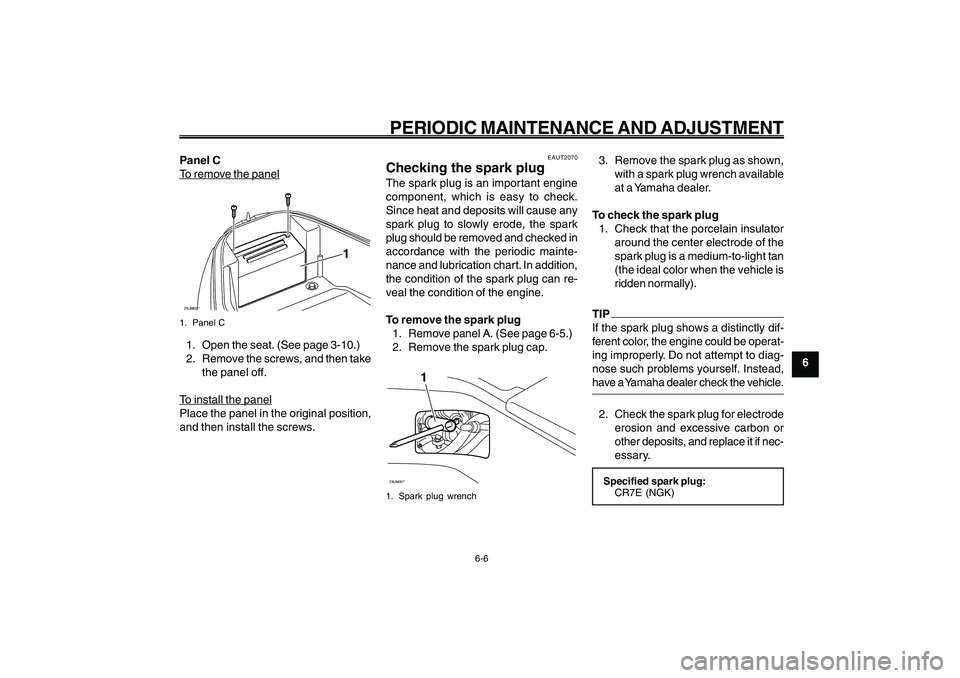
6-41
1
2
3
4
5
6
7
8
9
EAU1722A
PERIODIC MAINTENANCE AND ADJUSTMENT
6-6
Panel CTo remo
ve the panel
ZAUM00**
1
1. Panel C1. Open the seat. (See page 3-10.)
2. Remove the screws, and then take
the panel off.To install the panel
Place the panel in the original position,
and then install the screws.
EAUT2070
Checking the spark plugThe spark plug is an important engine
component, which is easy to check.
Since heat and deposits will cause any
spark plug to slowly erode, the spark
plug should be removed and checked in
accordance with the periodic mainte-
nance and lubrication chart. In addition,
the condition of the spark plug can re-
veal the condition of the engine.
To remove the spark plug
1. Remove panel A. (See page 6-5.)
2. Remove the spark plug cap.ZAUM00**
1
1. Spark plug wrench
Spark plug, checking
3. Remove the spark plug as shown,
with a spark plug wrench available
at a Yamaha dealer.
To check the spark plug
1. Check that the porcelain insulator
around the center electrode of the
spark plug is a medium-to-light tan
(the ideal color when the vehicle is
ridden normally).
TIP
If the spark plug shows a distinctly dif-
ferent color, the engine could be operat-
ing improperly. Do not attempt to diag-
nose such problems yourself. Instead,
have a Yamaha dealer check the vehicle.2. Check the spark plug for electrode
erosion and excessive carbon or
other deposits, and replace it if nec-
essary.Specified spark plug:
CR7E (NGK)
Page 42 of 74

6-42
1
2
3
4
5
6
7
8
9
EAU1722A
PERIODIC MAINTENANCE AND ADJUSTMENT
6-7
To install the spark plug
1. Measure the spark plug gap with a
wire thickness gauge and, if nec-
essary, adjust the gap to specifi-
cation.Spark plug gap:
0.7 ~ 0.8 mm (0.028 ~ 0.031 in)2. Clean the surface of the spark plug
gasket and its mating surface, and
then wipe off any grime from the
spark plug threads.
3. Install the spark plug with the spark
plug wrench, and then tighten it to
the specified torque.Tightening torque:
Spark plug:
TIP
If a torque wrench is not available when
installing a spark plug, a good estimate
of the correct torque is 1/4~1/2 turn past
finger tight. However, the spark plugshould be tightened to the specified
torque as soon as possible.
4. Install the spark plug cap.
5. Install the panel.
EAUT2592
Engine oilThe engine oil level should be checked
before each ride. In addition, the oil must
be changed and the oil strainer cleaned
at the intervals specified in the periodic
maintenance and lubrication chart.
To check the engine oil level
1. Place the vehicle on the
centerstand. A slight tilt to the side
can result in a false reading.
2. Start the engine, warm it up for sev-
eral minutes, and then turn it off.ZAUM00**
1
2
3
1. Engine oil filler cap
2. Maximum level mark
3. Minimum level mark
Engine oil